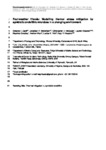Foul‐weather friends: Modelling thermal stress mitigation by symbiotic endolithic microbes in a changing environment
| dc.contributor.author | Zardi, GI | |
| dc.contributor.author | Monsinjon, JR | |
| dc.contributor.author | McQuaid, CD | |
| dc.contributor.author | Seuront, L | |
| dc.contributor.author | Orostica, M | |
| dc.contributor.author | Want, A | |
| dc.contributor.author | Firth, Louise | |
| dc.contributor.author | Nicastro, KR | |
| dc.date.accessioned | 2021-08-09T11:26:16Z | |
| dc.date.issued | 2021-06 | |
| dc.identifier.issn | 1354-1013 | |
| dc.identifier.issn | 1365-2486 | |
| dc.identifier.uri | http://hdl.handle.net/10026.1/17480 | |
| dc.description.abstract |
<jats:title>ABSTRACT</jats:title><jats:p>Temperature extremes are predicted to intensify with climate change. These extremes are rapidly emerging as a powerful driver of species distributional changes with the capacity to disrupt the functioning and provision of services of entire ecosystems, particularly when they challenge ecosystem engineers. The subsequent search for a robust framework to forecast the consequences of these changes mostly ignores within‐species variation in thermal sensitivity. Such variation can be intrinsic, but can also reflect species interactions. Intertidal mussels are important ecosystem engineers that host symbiotic endoliths in their shells. These endoliths unexpectedly act as conditionally beneficial parasites that enhance the host's resistance to intense heat stress. To understand how this relationship may be altered under environmental change, we examined the conditions under which it becomes advantageous by reducing body temperature. We deployed biomimetic sensors (robomussels), built using shells of mussels (<jats:italic>Mytilus galloprovincialis</jats:italic>) that were or were not infested by endoliths, at nine European locations spanning a temperature gradient across 22°of latitude (Orkney, Scotland to the Algarve, Portugal). Daily wind speed and solar radiation explained the maximum variation in the difference in temperature between infested and non‐infested robomussels; the largest difference occurred under low wind speed and high solar radiation. From the robomussel data, we inferred body temperature differences between infested and non‐infested mussels during known heatwaves that induced mass mortality of the mussel <jats:italic>Mytilus edulis</jats:italic> along the coast of the English Channel in summer 2018 to quantify the thermal advantage of endolith infestation during temperature extremes. Under these conditions, endoliths provided thermal buffering of between 1.7°C and 4.8°C. Our results strongly suggest that sustainability of intertidal mussel beds will increasingly depend on the thermal buffering provided by endoliths. More generally, this work shows that biomimetic models indicate that within‐species thermal sensitivity to global warming can be modulated by species interactions, using an intertidal host–symbiont relationship as an example.</jats:p> | |
| dc.format.extent | 2549-2560 | |
| dc.format.medium | Print-Electronic | |
| dc.language | en | |
| dc.language.iso | en | |
| dc.publisher | Wiley | |
| dc.subject | biophysical model | |
| dc.subject | climate change | |
| dc.subject | mussels | |
| dc.subject | mutualism | |
| dc.subject | thermal tolerance | |
| dc.title | Foul‐weather friends: Modelling thermal stress mitigation by symbiotic endolithic microbes in a changing environment | |
| dc.type | journal-article | |
| dc.type | Journal Article | |
| plymouth.author-url | https://www.webofscience.com/api/gateway?GWVersion=2&SrcApp=PARTNER_APP&SrcAuth=LinksAMR&KeyUT=WOS:000636215900001&DestLinkType=FullRecord&DestApp=ALL_WOS&UsrCustomerID=11bb513d99f797142bcfeffcc58ea008 | |
| plymouth.issue | 11 | |
| plymouth.volume | 27 | |
| plymouth.publication-status | Published | |
| plymouth.journal | Global Change Biology | |
| dc.identifier.doi | 10.1111/gcb.15616 | |
| plymouth.organisational-group | /Plymouth | |
| plymouth.organisational-group | /Plymouth/Faculty of Science and Engineering | |
| plymouth.organisational-group | /Plymouth/Faculty of Science and Engineering/School of Biological and Marine Sciences | |
| plymouth.organisational-group | /Plymouth/REF 2021 Researchers by UoA | |
| plymouth.organisational-group | /Plymouth/REF 2021 Researchers by UoA/UoA07 Earth Systems and Environmental Sciences | |
| plymouth.organisational-group | /Plymouth/Users by role | |
| plymouth.organisational-group | /Plymouth/Users by role/Academics | |
| dc.publisher.place | England | |
| dcterms.dateAccepted | 2021-02-21 | |
| dc.rights.embargodate | 2022-4-3 | |
| dc.identifier.eissn | 1365-2486 | |
| dc.rights.embargoperiod | Not known | |
| rioxxterms.versionofrecord | 10.1111/gcb.15616 | |
| rioxxterms.licenseref.uri | http://www.rioxx.net/licenses/all-rights-reserved | |
| rioxxterms.licenseref.startdate | 2021-06 | |
| rioxxterms.type | Journal Article/Review |


